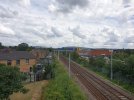An ambitious multi-billion-pound rail upgrade in West Yorkshire has now been given the green light, bringing a faster, greener, better-connected railway one step closer for passengers in the North of England. It’s the biggest milestone the Transpennine Route Upgrade has ever achieved.
Network Rail now has the go-ahead to completely transform train journeys between Huddersfield and Westtown (Dewsbury) as part of the
Transpennine Route Upgrade. The mammoth scheme will see twice as many tracks installed, major renovations at Huddersfield, Deighton, Mirfield and Ravensthorpe stations, and the track layout reimagined.
As well as supporting rapid economic growth in the North of England, these major improvements will ultimately deliver more frequent, faster trains along a cleaner, greener, more reliable railway between York and Manchester.
The
Transport and Works Act Order – required for any project that involves building new sections of railway outside of the existing boundaries – was approved by the Secretary of State for Transport on Monday (27 June) six months earlier than planned, kickstarting progress on the ambitious plans and designs. It’s one of the biggest applications ever made by Network Rail.




